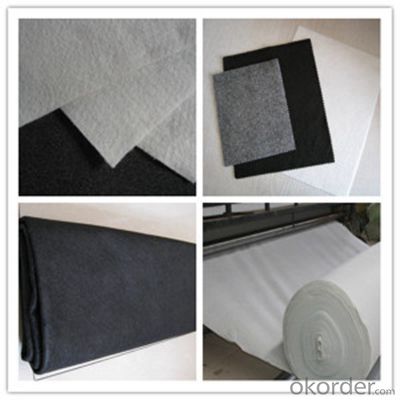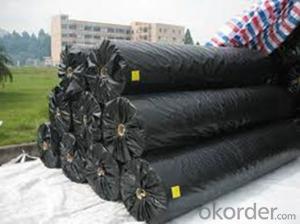Geotextile Bag Non-woven Geotextiles Bag
- Loading Port:
- China main port
- Payment Terms:
- TT OR LC
- Min Order Qty:
- 1000 m²
- Supply Capability:
- 100000 m²/month
OKorder Service Pledge
OKorder Financial Service
You Might Also Like
Item specifice
Product Introduction
Detail
Non woven Geotextiles bag
Made by polyester(PET) or polyproplence(PP)fiber as the raw material,making double sides ironed and pressed needle-punched non-woven geotextile through the spun bonded technology,and then processed to bag with specified dimension, and tnen spray seeds which are suitable for local climate, form a new product which could restore or create a new ecosystem.
Specification
1,) Plane size range: (can be made according to the requirements of the design and engineering)
2,) Cloth gram weight range: 100g/m2~500g/m2
3,) Tensile strength≥4.5kn/m
4,) Elongation at break: ≥40‰
Specification | 110GSM | 130GSM | 150GSM |

Packaging & Shipping
Packing: PLASTIC FILM INSIDE, AND WOVEN BAG OUTSIDE
Shipping: About 15 days after receipt the deposit
pecifications
geotextile fabric
permeability,filtration,easy for construction
ISO and CE certificate
Good quality and competitive price
Our Service
Quality assurance
1.On a regular basis or as per your request,we entrust national testing agencies to conduct quality inspections
2. Strictly in accordance with the ISO9001-2008 international quality system standard,we monitor and manage the whole process throughout production,quality testing,and measurement to ensure product quality
3. For quality-related construction delay or substandard construction(except for damage or losses due to customer’s responsibility or irresistible natural disasters),we have refunding,replacement,and repair services.We will respond to customers’ feedbacks on quality issues within 24 hours.
FAQ:
Q: What kind of payments does jenor support?
A: T/T, L/C, Cash are accepted.
Q: Do you charge for the samples?
A: Accordeing to our company policy, the samples are free, we only charge the freight fee. And we will return the freight fee during the next order.
Q: Can you produce according to customers' design?
A: Sure, we are professional manufacturer, OEM and ODM are both welcome.
Q: Do you have other products?
A: Yes, please check the pictures:
- Q:How do geotextiles contribute to the environmental sustainability of construction projects?
- Geotextiles contribute to the environmental sustainability of construction projects by providing various benefits. They act as a barrier between the soil and construction materials, preventing erosion and sedimentation. This minimizes the release of pollutants into water bodies, thus protecting water quality. Geotextiles also help in stabilizing slopes and retaining walls, reducing the need for additional materials and resources. Moreover, they enhance soil drainage, reducing the risk of flooding and soil erosion. Overall, geotextiles promote sustainable construction practices by minimizing environmental impacts and preserving natural resources.
- Q:What is the expected lifespan of geotextiles?
- The expected lifespan of geotextiles can vary depending on factors such as the material used, the specific application, and the environmental conditions. However, on average, geotextiles are designed to have a lifespan of at least 25 to 30 years.
- Q:How to apply the geotextile of the retaining wall filter
- Our manufacturer, a professional construction team
- Q:What are the main functions of geotextiles?
- The main functions of geotextiles are to provide separation, filtration, reinforcement, and drainage in various civil engineering applications. They help prevent the mixing of different soil layers, enhance soil stability, control erosion, and allow for the efficient flow of water.
- Q:Geotextile vertical permeability coefficient to retain a few digits
- According to GB / T-1998 in the short wire geotextile permeability coefficient, K = 1.0-9.9 between, so this coefficient should be retained after a decimal.
- Q:what is the purpose of geotextile on gabion walls.?
- Geotextiles are fabrics associated with soil, earth or rocks. Gabions were earth filled barricades meant to halt enemy fire during battle. I'm guessing geotextiles on gabion walls more effectively hold back the earth or filler. They might have well suited permeability or retentive qualities for gabions. There are a few other definitions for gabions. But this is the militaristic definition. Gabions are also used in dams and such. In this case, geotxtiles might have good properties for being submerged in water and still retaining whats inside the gabions.
- Q:What are the different geotextile manufacturing processes?
- There are several different geotextile manufacturing processes, including needle punching, thermal bonding, spunbonding, and weaving. Each process has its own advantages and is used depending on the desired properties and applications of the geotextile. Needle punching involves mechanically interlocking fibers, thermal bonding uses heat to bond fibers together, spunbonding creates a nonwoven fabric through extrusion and stretching, and weaving involves interlacing yarns to create a fabric. These processes allow for the production of geotextiles with various strengths, permeabilities, and filtration capabilities, making them suitable for a wide range of civil engineering and environmental applications.
- Q:Can geotextiles be used for filtration of contaminants in water?
- Yes, geotextiles can be used for filtration of contaminants in water. Geotextiles are permeable fabrics that can effectively filter out suspended particles, sediments, and pollutants from water. They are commonly used in various applications such as wastewater treatment, erosion control, and geotechnical engineering to improve water quality by removing contaminants through filtration.
- Q:How do geotextiles help with load distribution in pavement systems?
- Geotextiles provide a reinforcing and stabilizing function in pavement systems by distributing applied loads more evenly across the underlying soil, reducing stress concentrations, and preventing the formation of cracks and deformations.
- Q:Are geotextiles suitable for use in retaining walls?
- Yes, geotextiles are suitable for use in retaining walls. They provide excellent soil separation, filtration, and drainage capabilities, enhancing the stability and longevity of the wall. Geotextiles can effectively prevent soil erosion, control water flow, and reinforce the structure of the retaining wall, making them an ideal solution for such applications.
1. Manufacturer Overview |
|
|---|---|
| Location | |
| Year Established | |
| Annual Output Value | |
| Main Markets | |
| Company Certifications | |
2. Manufacturer Certificates |
|
|---|---|
| a) Certification Name | |
| Range | |
| Reference | |
| Validity Period | |
3. Manufacturer Capability |
|
|---|---|
| a)Trade Capacity | |
| Nearest Port | |
| Export Percentage | |
| No.of Employees in Trade Department | |
| Language Spoken: | |
| b)Factory Information | |
| Factory Size: | |
| No. of Production Lines | |
| Contract Manufacturing | |
| Product Price Range | |
Send your message to us
Geotextile Bag Non-woven Geotextiles Bag
- Loading Port:
- China main port
- Payment Terms:
- TT OR LC
- Min Order Qty:
- 1000 m²
- Supply Capability:
- 100000 m²/month
OKorder Service Pledge
OKorder Financial Service
Similar products
New products
Hot products
Hot Searches
Related keywords






























